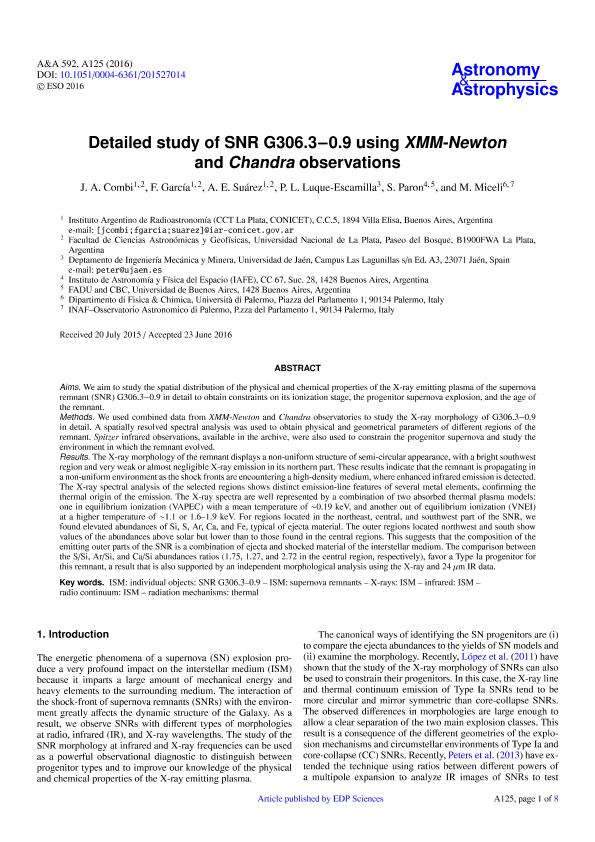Mostrar el registro sencillo del ítem
dc.contributor.author
Combi, Jorge Ariel

dc.contributor.author
García, Federico

dc.contributor.author
Suárez, Alejandra Etelvina

dc.contributor.author
Luque Escamilla, Pedro
dc.contributor.author
Paron, Sergio Ariel

dc.contributor.author
Miceli, Marco
dc.date.available
2017-08-04T19:57:48Z
dc.date.issued
2016-06
dc.identifier.citation
Combi, Jorge Ariel; García, Federico; Suárez, Alejandra Etelvina; Luque Escamilla, Pedro; Paron, Sergio Ariel; et al.; Detailed study of SNR G306.3-0.9 using XMM-Newton and Chandra observations; EDP Sciences; Astronomy and Astrophysics; 592; A125; 6-2016; 1-8
dc.identifier.issn
0004-6361
dc.identifier.uri
http://hdl.handle.net/11336/21900
dc.description.abstract
Aims. We aim to study the spatial distribution of the physical and chemical properties of the X-ray emitting plasma of the supernovaremnant (SNR) G306.3−0.9 in detail to obtain constraints on its ionization stage, the progenitor supernova explosion, and the age ofthe remnant.Methods. We used combined data from XMM-Newton and Chandra observatories to study the X-ray morphology of G306.3−0.9 in detail. A spatially resolved spectral analysis was used to obtain physical and geometrical parameters of different regions of the remnant. Spitzer infrared observations, available in the archive, were also used to constrain the progenitor supernova and study the environment in which the remnant evolved.Results. The X-ray morphology of the remnant displays a non-uniform structure of semi-circular appearance, with a bright southwest region and very weak or almost negligible X-ray emission in its northern part. These results indicate that the remnant is propagating in a non-uniform environment as the shock fronts are encountering a high-density medium, where enhanced infrared emission is detected. The X-ray spectral analysis of the selected regions shows distinct emission-line features of several metal elements, confirming the thermal origin of the emission. The X-ray spectra are well represented by a combination of two absorbed thermal plasma models: one in equilibrium ionization (VAPEC) with a mean temperature of ∼0.19 keV, and another out of equilibrium ionization (VNEI) at a higher temperature of ∼1.1 or 1.6?1.9 keV. For regions located in the northeast, central, and southwest part of the SNR, wefound elevated abundances of Si, S, Ar, Ca, and Fe, typical of ejecta material. The outer regions located northwest and south show values of the abundances above solar but lower than to those found in the central regions. This suggests that the composition of the emitting outer parts of the SNR is a combination of ejecta and shocked material of the interstellar medium. The comparison between the S/Si, Ar/Si, and Ca/Si abundances ratios (1.75, 1.27, and 2.72 in the central region, respectively), favor a Type Ia progenitor for this remnant, a result that is also supported by an independent morphological analysis using the X-ray and 24 µm IR data.
dc.format
application/pdf
dc.language.iso
eng
dc.publisher
EDP Sciences

dc.rights
info:eu-repo/semantics/openAccess
dc.rights.uri
https://creativecommons.org/licenses/by-nc-sa/2.5/ar/
dc.subject
Ism: Individual Objects: G306.3-0.9
dc.subject
Ism: Supernova Remnants
dc.subject
X-Ray: Ism
dc.subject
Radiation Mechanism: Thermal
dc.subject.classification
Astronomía

dc.subject.classification
Ciencias Físicas

dc.subject.classification
CIENCIAS NATURALES Y EXACTAS

dc.title
Detailed study of SNR G306.3-0.9 using XMM-Newton and Chandra observations
dc.type
info:eu-repo/semantics/article
dc.type
info:ar-repo/semantics/artículo
dc.type
info:eu-repo/semantics/publishedVersion
dc.date.updated
2017-07-27T12:49:33Z
dc.journal.volume
592
dc.journal.number
A125
dc.journal.pagination
1-8
dc.journal.pais
Francia

dc.journal.ciudad
Paris
dc.description.fil
Fil: Combi, Jorge Ariel. Provincia de Buenos Aires. Gobernación. Comision de Investigaciones Científicas. Instituto Argentino de Radioastronomía. Consejo Nacional de Investigaciones Científicas y Técnicas. Centro Científico Tecnológico Conicet - La Plata. Instituto Argentino de Radioastronomia; Argentina. Universidad Nacional de la Plata. Facultad de Ciencias Astronómicas y Geofísicas; Argentina
dc.description.fil
Fil: García, Federico. Provincia de Buenos Aires. Gobernación. Comision de Investigaciones Científicas. Instituto Argentino de Radioastronomía. Consejo Nacional de Investigaciones Científicas y Técnicas. Centro Científico Tecnológico Conicet - La Plata. Instituto Argentino de Radioastronomia; Argentina. Universidad Nacional de la Plata. Facultad de Ciencias Astronómicas y Geofísicas; Argentina
dc.description.fil
Fil: Suárez, Alejandra Etelvina. Provincia de Buenos Aires. Gobernación. Comision de Investigaciones Científicas. Instituto Argentino de Radioastronomía. Consejo Nacional de Investigaciones Científicas y Técnicas. Centro Científico Tecnológico Conicet - La Plata. Instituto Argentino de Radioastronomia; Argentina. Universidad Nacional de la Plata. Facultad de Ciencias Astronómicas y Geofísicas; Argentina
dc.description.fil
Fil: Luque Escamilla, Pedro. Universidad de Jaén; España
dc.description.fil
Fil: Paron, Sergio Ariel. Consejo Nacional de Investigaciónes Científicas y Técnicas. Oficina de Coordinación Administrativa Ciudad Universitaria. Instituto de Astronomía y Física del Espacio. - Universidad de Buenos Aires. Facultad de Ciencias Exactas y Naturales. Instituto de Astronomía y Física del Espacio; Argentina
dc.description.fil
Fil: Miceli, Marco. Osservatorio Astronomico Di Palermo; Italia
dc.journal.title
Astronomy and Astrophysics

dc.relation.alternativeid
info:eu-repo/semantics/altIdentifier/doi/http://dx.doi.org/10.1051/0004-6361/201527014
dc.relation.alternativeid
info:eu-repo/semantics/altIdentifier/url/https://www.aanda.org/articles/aa/abs/2016/08/aa27014-15/aa27014-15.html
dc.relation.alternativeid
info:eu-repo/semantics/altIdentifier/url/https://arxiv.org/pdf/1606.08940.pdf
Archivos asociados
